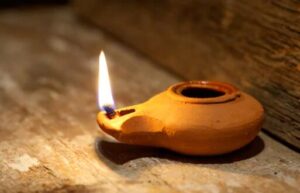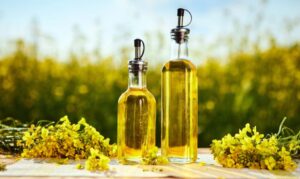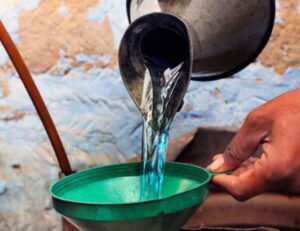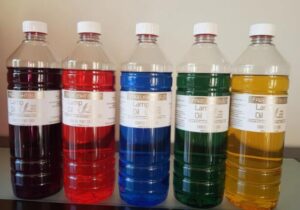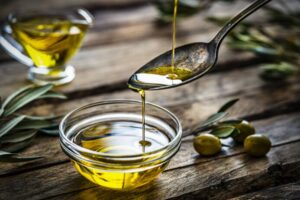Oil lamps are among the first invention that came up during the development of lamps. However, they have not yet grown out of fashion, as most people still use them for many other reasons.
As the name indicates, they are oil lamps, and thus they use oil as their primary source of fuel; with so many types of oils, it is important to know the exact type of oil you should use in your oil lamps.
Knowing the right oil means that you will avoid the emission of any poisons caused by the burning of harmful oils. The following is what you need to know about the types of lamp oil.
High Recommend Lamp Oil:
Smokeless and Odor Free, Great for Children and Pet Home: Hyoola Kerosene Paraffin Oil
Pure and Organic, Great for Allergic Family: AmazonFresh Olive Oil
Contemporary Oils and Organic Lamp Fuel
Lamp oil always seems to have one specific type of oil to fuel it, but the truth is there is a wide variety of oils you can use to fuel your oil lamps.
However, it is crucial to understand that not all oil alternatives can work best in any antique kerosene and paraffin oil lamps.
The following are the main types of contemporary oils and organic lamp fuels one should always be conversant with:
1. Canola oil
It is extracted from crushed grape seeds, this oil is suitable for use as organic oil lamp fuel, but it contains several unsaturated compounds that are likely to make the oil produce a resin making the lamp’s wick clog.
Characteristics:
- Contains unsaturated compounds
- High levels of alpha-linolenic acid
2. Castor oil
This is a vegetable-based oil extracted from castor beans and Ricinus communis. Castor oil is a renewable energy source as it easily biodegrades; today, several countries such as Egypt and India have used castor oil to fuel their oil lamps.
Characteristics:
- It is environmental and user friendly since it is highly biodegradable
- It is naturally extracted from castor seeds with no added many other chemicals
3. Fish oil
Fish oils are extracted from the tissues of any oily fishes; it was among the traditional oil that was used to fuel lamps over the past several centuries.
However, it has been found to have several drawbacks, such as it does not produce brighter flames, and when used for an extended period, it will produce some harmful smoke.
Characteristics:
- Does not produce brighter flames
- It produces smoke when burned for long periods
4. Kerosene
Kerosene is one of the highly available and affordable refined oil used to light oil lamps; it was discovered by Abraham Gesner, a medical doctor, in 1846 where he tried to distill coal where he ended up producing a clear fluid.
Later on, he realized that when this clear fluid is used to fuel traditional oil lamps, it produces a very bright yellow flame, which was very bright than any other fuel used to power oil lamps.
He decided to name the fluid kerosene, a Greek word meaning wax oil.
Characteristics:
- Produces very bright flames
- It works best outdoors, where the smell it produces dissolves in excess air circulation
5. Lamp Oil
This is a highly flammable hydrocarbon oil that has been highly refined and purified to ensure that it burns, producing zero odor and the minimum soot levels possible.
There are three lamp oil categories: clear lamp oil, scented and colored oils; the clear lamp oil is designed for use in indoor oil lamps.
The scented lamp oil sometimes becomes smoky when in use this makes them suitable for outside lamp oils, especially camping ones, and the colored lamp oils can be used either for an indoor or outdoor lamp.
However, it easily stains and can cause your lamp and its contents to discolor, a feature not anyone would desire.
Lamp oils can easily evaporate when exposed to the open air, and this means that when storing your lamp, ensure the caps be it for the lamp or the storage container is well-fitting.
Characteristics:
- Does not produce bad smells or smoke.
- High end
- Does not produce any soot when burned
- Some are scented to produce sweet smells when burnt
6. Olive oil
Olive oil is the most famous alternative for oil lamps and kerosene as it does not produce any bad smell; neither does it produce smoke.
The laminate oils are known to be the lowest quality of virgin olive oil and should not be consumed by human beings not unless it is refined. It best works with thick wicks since it does burn easily up to 550 degrees F.
Characteristics:
- It is odorless
- Does not produce any smoke when burned
7. Palm kernel oil
The oil is extracted from oil palm kernel; it is considered as a low viscosity paraffin oil. Lately, it is rare to find palm oil due to the increasing demand for renewable raw materials.
It is also highly preferred because it does not produce any smell; it is non-flammable and safe to use in homes full of small children and pets.
Characteristics:
- Non-flammable making it safe to use in any environment
- Produces very minimal smell and smoke when burnt
Paraffin Lamp Oil vs. Kerosene
Fuel-burning lamps and lanterns are always used for many various reasons or activities. A decorative lamp can make a complete change to your home for a party or any small celebration.
Most lanterns are specifically used for camping purposes; however, either can be used for either activities, lighting or camping. Therefore you should understand what is between paraffin oil and kerosene.
Here is what you should know about them:
-
Kerosene
Two primary types of kerosene are; red kerosene and K-1; red kerosene happens to be cheaper than the K-1 kerosene-type; thus, its name red kerosene due to its tax factors.
The red kerosene is mostly used in generators and tractors since it burns faster than the other type meaning its replacement should be done more frequently.
Red kerosene should not be burned anyhow because it harmful to human health as it produces harmful gases due to the dye by-products.
K-1 kerosene is readily available and cheap; therefore, it is the best fueling choice for lamps and lanterns.
It can be purchased in any fuel filling station or even at retailer shops that focus on oil lamps; it contains sulfur and several impurities, which causes an unpleasant smell when it is burning.
Therefore, it is advisable to burn the kerosene outside to avoid the bad smell, but the smell is not harmful to human health, not unless one suffers from allergic reactions.
-
Lamp oil
Lamp oil belongs to a similar category as kerosene; however, it is highly purified to ensure that it burns cleanly.
Burning lamp oil leads to the production of very small pollutants, unlike when burning kerosene; one major thing is that it produces no bad smells like the ones produced by kerosene; moreover, lamp oil can be purchased in different scents.
Lamp oil is slightly expensive than kerosene; furthermore, you can purchase lamp oil in even supermarkets, unlike kerosene found only in specific places.
But, lamp oil does not burn to produce brighter flames like the ones produced by kerosene.
- Final Verdict:
From the above, we can conclude that it can be cheap to use kerosene for burning than using lamp oil. However, lamp oil burns cleanly and does not produce any bad smells.
Therefore, if you are looking for fuel to use for outdoor purposes, consider choosing kerosene since it burns brightly, and with inadequate air circulation, the bad odor disappears.
For indoor burning fuel, consider picking the lamp oil as it is safer and does not expose you to anything harmful to your health.
Tips for Safely Fueling Your Oil Lamp
To ensure that you safely fuel your oil lamp, you should understand several key things you should do and avoid. Here is what is expected from you when you are feeling any oil lamp:
1. Before you start the fueling process, ensure that all the drapes, decorations and any other highly flammable items are nowhere near your oil lamp since they can easily catch flames and lead to more dangers.
2. When filling the lamp with the lamp oil of your choice, there might be spills; clean the spillage using an absorbent piece of cloth together with grease-cutting detergent to prevent the flame from getting outside the flame.
3. Always consider using a liquid funnel to fill oil lamps; this is tricky that will reduce oil spillages and ensure more safety. Ensure that the lamp is extinguished when you are filling it, do not fill a lit lamp; the damages it might cause may never get repaired.
4. Avoid using mineral oil, pure gasoline or rubbing alcohol as fuel for your oil lamp; this is because the named materials are not safe for human health as they produce dangerous vapors and aromatics when burned.
5. Do not use highly ignitable substances to fill your fuel reservoir for the oil lamp since they might lead to fire, respiratory illness or even explosions.
FAQs
1. Can I Burn Olive Oil in a Lamp?
Yes! Olive oil can be used in oil lamps as a fuel source; however, it should not be used with all oil lamps.
You should burn olive oil in vegetable oil lamps; since it takes a long time to burn in a wick, it is advisable to use a thick wick in your intended oil lamp.
Olive oil does not work well with wick type lamps, but there is an option of retrofitting your oil lamp.
2. Can You Use TIKI Torch Oil in an Oil Lamp?
Yes!
Sometimes it is tempting when choosing the right oil to use in your oil lamp; no matter how hard it gets for you, avoid experimenting with different lamp oils since this is not good.
Therefore, it is crucial to go for oils that have been specifically designed for oil lamps; if you feel confused, consult, and you will find what you want.
Tiki torch oil is petroleum-based, and therefore it is meant to be used outdoors as it also repels insects it produces smoke when burned.
However, if you must use the tiki torch oil, you should use it outside, and you can increase its life by using it with half kerosene. The tiki torch oil is approved for use outdoors.
3. What Is Lamp Oil Made out of?
Lamp oil is made out of kerosene and paraffin from refined petroleum. Petroleum is heated under intense heat then the vapors are condensed to form liquids.
The condensed paraffin-kerosene liquids are later refined into lamp oil, free from producing smoke and bad odor. Chemical proportions in lamp oil vary depending on the manufacturers and the different processes they go through.
4. Does Lamp Oil Evaporate?
Lamp oil manufactured from the components of paraffin and kerosene slowly evaporates over time. To ensure that your lamp oil achieves the maximum shelf life possible, always store them in well-fitting cap containers.
Lamp oil evaporation reduces the oil’s shelf life as it makes it to become thick and useless. However, lamp oil is better when it comes to evaporating, unlike gasoline.
Therefore, it is crucial if one tries to prevent lamp oil evaporation and always check your lamp oil bottle’s condition.
Inspect it, and if you notice any cloudy or discoloration features, then it means that it’s old enough to be replaced. It appears to be clear, then that is a guarantee that the oil is safe for use.
5. How Long Does Lamp Oil Last?
Unlike many other solvents that degrade with time, lamp oil is one stable solvent that can last for a very long period.
It has been found out that unrefined oils can last for over a billion years, petroleum-based lamp oils have very different features, and therefore the conditions they will be exposed to determine how long they will last.
We can generally say that any lamp oil that has stayed for long can still be burned in an oil lamp; however, if it was stored in a metal or plastic container for an extended period, there might be chances that the molecules are stained.
Meaning that the more it stays, the less refined it becomes, making it a bad idea to use aged oil indoors; you should use it outdoors.
Conclusion
Understanding everything you need to know about oil lamps, and the type of oil to use with them will alleviate many costs and dangers.
Before making a decision, do proper research or even consult an expert to help you pick the right things reducing the harmful and dangerous effects that may arise from using the wrong tools in your oil lamp.

